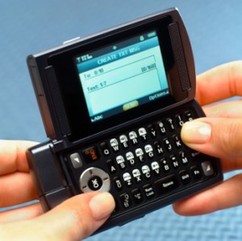跟朋友發(fā)短信或者在網(wǎng)上聊天的時候,總是會看到lol,ttul等讓人摸不著頭腦的一些縮略語,想直接問人家吧,又怕被人家笑話。到網(wǎng)上一搜才發(fā)現(xiàn),原來這些都屬于textese(短信文),(lol是laugh out loud,ttul指talk to you later),是人們?yōu)榱税l(fā)短信方便創(chuàng)造出來的,

Textese (also known as txtese, chatspeak, textspeak, texting language, or txt talk) is a term for the abbreviations and slang most commonly used due to the necessary brevity of mobile phone text messaging, though its use is common on the Internet, including e-mail and instant messaging. It can be likened to a rebus, which uses pictures and single letters, or numbers to represent whole words (e.g, "i <3 u" means “I love you”, b4 means before, lol means laugh out loud, etc. ).
短信文(英文為textese,也可以用txtese, chatspeak, textspeak, texting language, 或 txt talk來表示)指為了保證手機短信的簡短而使用的縮寫和俗語表達,現(xiàn)在也通用于電子郵件和即時信息等網(wǎng)絡(luò)交流工具中。這種短信文是由圖片、字母或數(shù)字的組合來代表某個單詞的,感覺像字謎一樣。比如:"i <3 u"就代表“我愛你”(中間的<3像是一顆心的形狀,代表“愛”),b4就是before(以前)這個單詞的縮寫形式,而lol則是laugh out loud(大聲笑出來)這三個單詞的縮寫。
The objective of textese is to use the fewest number of characters needed to convey a comprehensible message, another benefit of textese is to reduce the character count of a message, hence, punctuation, grammar, and capitalization are largely ignored.
短信文出現(xiàn)的目的是用最少的字母來傳遞意思完整的信息,另外,因為短信文可以減少信息中使用的字符數(shù),所以標(biāo)點符號、語法以及大小寫等規(guī)則在短信文中也都被忽略了。
相關(guān)閱讀
(中國日報網(wǎng)英語點津 Helen 編輯)
